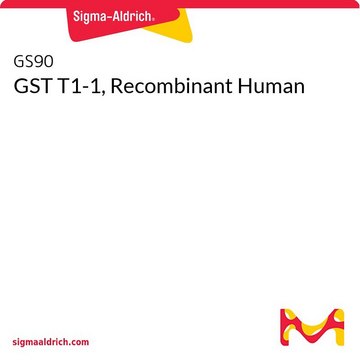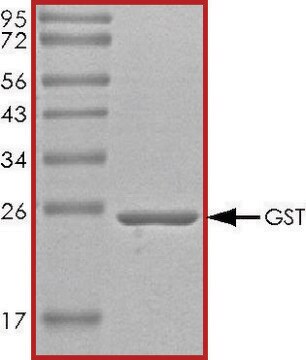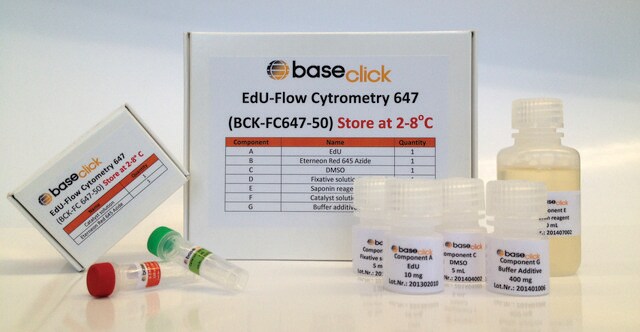GS52
GST T2-2, Recombinant Human
Sinónimos:
glutathione S-transferase theta 2
Iniciar sesiónpara Ver la Fijación de precios por contrato y de la organización
About This Item
UNSPSC Code:
12352200
NACRES:
NA.26
Productos recomendados
biological source
human
Quality Level
recombinant
expressed in E. coli
assay
>95% (SDS-PAGE)
form
frozen liquid
specific activity
12.6 units/mg protein
mol wt
25 kDa
concentration
1.91 mg/mL
storage temp.
−70°C
Gene Information
human ... GSTT2(2953)
General description
Glutathione S-transferase theta 2 (GSTT2) is an enzyme that in humans is encoded by the GSTT2 gene. GSTT2 is mapped to human chromosome 22q11.2.
as assayed by the spectrophotometric determination of NADPH oxidation coupled to the glutathione peroxidase activity of GST T2-2 on cumene hydroperoxide (1.5 mM) in the presence of reduced glutathione (1 mM) in 100 mM NaPO4 (pH 7.0) at room temperature.
Biochem/physiol Actions
Glutathione S-transferases (GSTs) are a family of enzymes that play an important role in detoxification by catalyzing the conjugation of many hydrophobic and electrophilic compounds with reduced glutathione. Based on their biochemical, immunologic, and structural properties, cytosolic and membrane-bound forms of glutathione S-transferase are encoded by two distinct supergene families. At present, eight distinct classes of the soluble cytoplasmic mammalian glutathione S-transferases have been identified: α, κ, μ, ω, π, σ, θ and ζ. The GSTs are thought to function in xenobiotic metabolism and play a role in susceptibility to cancer, and other diseases.
The θ class includes GSTT1, GSTT2, and GSTT2B. GSTT2 and GSTT2B are nearly identical to each other, and share 55% amino acid identity with GSTT1. All three genes may play a role in human carcinogenesis. The GSTT2 gene is a pseudogene in some populations.
Storage and Stability
The enzyme should be used by the end-user customer within 1 year of receipt.
Storage Class
10 - Combustible liquids
wgk_germany
WGK 1
flash_point_f
Not applicable
flash_point_c
Not applicable
Elija entre una de las versiones más recientes:
Certificados de análisis (COA)
Lot/Batch Number
¿No ve la versión correcta?
Si necesita una versión concreta, puede buscar un certificado específico por el número de lote.
¿Ya tiene este producto?
Encuentre la documentación para los productos que ha comprado recientemente en la Biblioteca de documentos.
Molecular cloning of a cDNA and chromosomal localization of a human theta-class glutathione S-transferase gene (GSTT2) to chromosome 22.
Tan K L, et al.
Genomics, 25(2), 381-387 (1995)
Glutathione transferases: substrates, inihibitors and pro-drugs in cancer and neurodegenerative diseases.
Allocati N, et al.
Oncogenesis, 7(1), 8-8 (2018)
Glutathione S-transferases: an overview in cancer research.
Di Pietro G, et al.
Expert Opinion on Drug Metabolism & Toxicology, 6(2), 153-170 (2010)
Structure, function and evolution of glutathione transferases: implications for classification of non-mammalian members of an ancient enzyme superfamily.
Sheehan D, et al.
The Biochemical Journal, 360(1), 1-16 (2001)
B Rodríguez-Santiago et al.
Molecular psychiatry, 15(10), 1023-1033 (2009-06-17)
Copy number variants (CNVs) are a substantial source of human genetic diversity, influencing the variable susceptibility to multifactorial disorders. Schizophrenia is a complex illness thought to be caused by a number of genetic and environmental effects, few of which have
Nuestro equipo de científicos tiene experiencia en todas las áreas de investigación: Ciencias de la vida, Ciencia de los materiales, Síntesis química, Cromatografía, Analítica y muchas otras.
Póngase en contacto con el Servicio técnico





